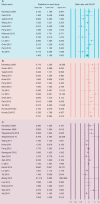PNPLA3 as a Genetic Determinant of Risk for and Severity of Non-alcoholic Fatty Liver Disease Spectrum
- PMID: 27777887
- PMCID: PMC5075002
- DOI: 10.14218/JCTH.2016.00009
PNPLA3 as a Genetic Determinant of Risk for and Severity of Non-alcoholic Fatty Liver Disease Spectrum
Abstract
Background and Aims:Patatin-like phospholipase domain protein 3 (PNPLA3) polymorphisms (rs738409 C>G) are associated with non-alcoholic fatty liver disease (NAFLD). We performed a systematic review and meta-analysis to examine the association of PNPLA3 polymorphisms with the spectrum and severity of this disease. Methods: Studies evaluating the association between the PNPLA3 polymorphism spectrum (fatty liver, steatohepatitis, cirrhosis, and hepatocellular carcinoma) and NAFLD were included. Pooled data are reported as odds ratios (ORs) with 95% confidence intervals. Results: Of 393 potentially relevant studies, 35 on NAFLD were included in the analysis. Compared to healthy controls, the pooled ORs for rs738409 CG and GG compared to CC among patients with non-alcoholic fatty liver (NAFL) were 1.46 (1.16-1.85) and 2.76 (2.30-3.13), and were 1.75 (1.24-2.46) and 4.44 (2.92-6.76) among patients with non-alcoholic steatohepatitis respectively. The respective ORs for CG and GG compared to the CC genotype were 2.35 (0.90-6.13) and 5.05 (1.47-17.29) when comparing non-alcoholic hepatocellular carcinoma to NAFL patients. Among the NAFLD patients, the ORs for G allele frequency when comparing steatosis grade 2-3 to grade 0-1 NAFL, when comparing the NAFLD activity score of ≥ 4 to score ≤ 3, when comparing NASH to NAFLD, when comparing the presence of lobular inflammation to absence, and when comparing the presence of hepatocyte ballooning to absence were 2.33 (1.43-3.80), 1.80 (1.36-2.37), 1.66 (1.42-1.94), 1.58 (1.19-2.10), and 2.63 (1.87-3.69) respectively. Subgroup analysis based on ethnicity showed similar results. Conclusions:PNPLA3 polymorphisms have strong association with the risk for and severity of NAFLDs. PNPLA3 polymorphism plays an evolving role in diagnosis and treatment decisions in patients with NAFLD.
Keywords: Non-alcoholic liver disease; PNPLA3; Polymorphisms; rs738409 C>G.
Conflict of interest statement
None
Figures







References
LinkOut - more resources
Full Text Sources
Other Literature Sources
